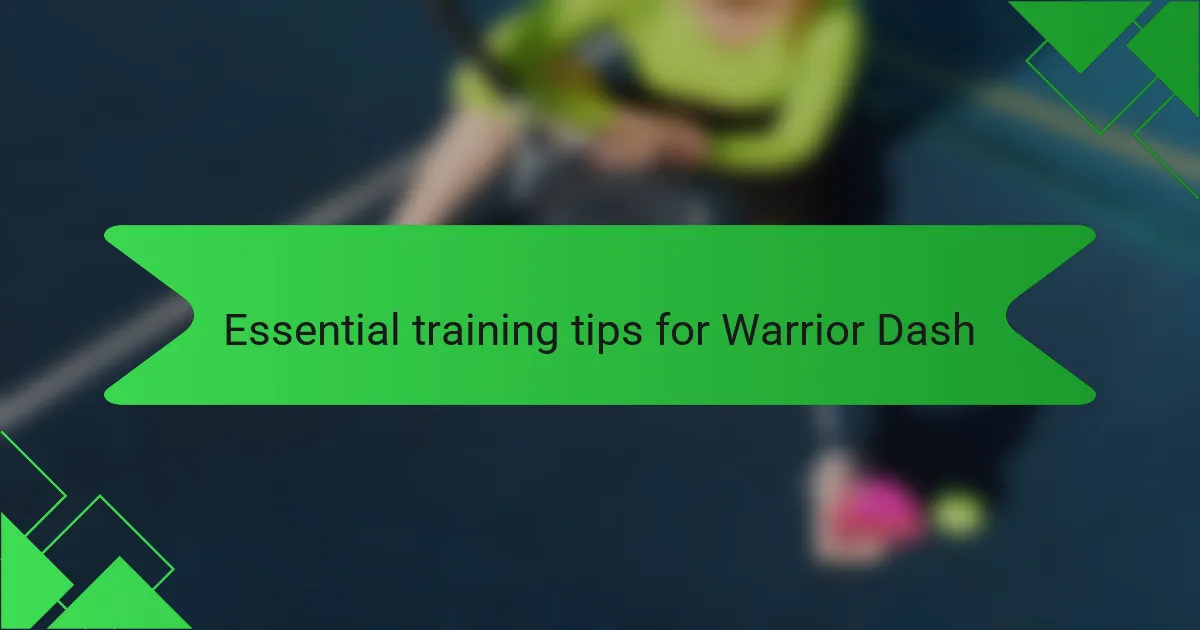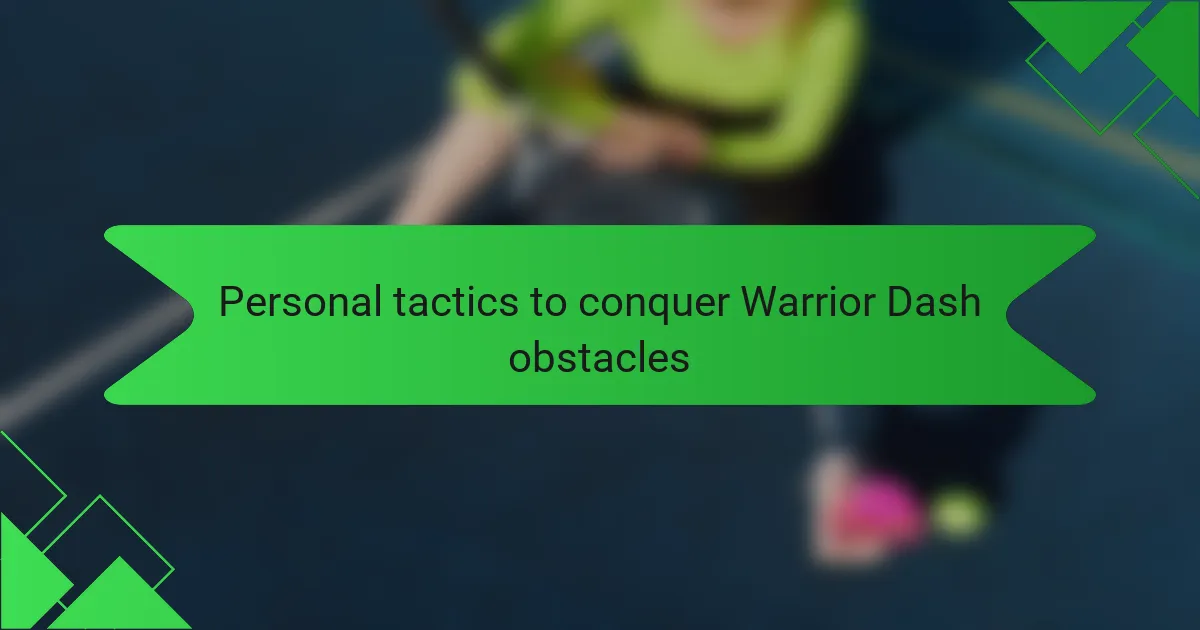Key takeaways
- Obstacle course racing combines physical and mental challenges, requiring strategy, adaptability, and teamwork.
- Proper training includes strength building, high-intensity interval practice, and mental preparation to boost confidence.
- Choosing appropriate gear, such as lightweight clothing and good grip shoes, enhances performance and comfort during the race.
- Nutrition and hydration play crucial roles in maintaining energy and stamina throughout the event.

What is obstacle course racing
Obstacle course racing (OCR) is a thrilling sport that combines running with challenging physical obstacles. From my experience, it’s not just about speed but problem-solving and pushing your limits in muddy, rugged terrain. Every race feels like a personal adventure where you conquer fear and build confidence with each obstacle.
| Aspect | Obstacle Course Racing |
|---|---|
| Physical Challenge | Mix of running, climbing, crawling, and jumping |
| Mental Challenge | Requires strategy, focus, and adaptability |
| Environment | Outdoor natural and rugged landscapes |
| Community | Supportive and encouraging fellow racers |
| Emotional Reward | Sense of accomplishment and personal growth |

Common Warrior Dash obstacles
Common Warrior Dash obstacles often combine physical challenge with a good dose of fun, which is what I love most about the race. From crawling under barbed wire to climbing over slippery walls, each obstacle tests your grit in a unique way. I found that mentally preparing for these diverse challenges helped me tackle them with less hesitation and more confidence.
| Obstacle | My Experience |
|---|---|
| Barbed Wire Crawl | Crawling close to the ground was tougher than expected, but staying low and steady kept me safe and focused. |
| Slippery Wall Climb | The slick surface almost threw me off balance, but teamwork and persistence helped me conquer it with a burst of adrenaline. |
| Fire Jump | Jumping over flames was intimidating, yet exhilarating—it gave me a huge confidence boost despite my initial nerves. |

Essential training tips for Warrior Dash
When I started training for Warrior Dash, I realized that running alone wasn’t enough. Incorporating strength training, especially focusing on upper body and core exercises, made climbing and crawling much less daunting during the race. Have you ever noticed how much those muscles are tested when you’re hauling yourself over a wall or squeezing under barbed wire?
I also found that practicing short bursts of high-intensity intervals helped mimic the race’s stop-and-go nature. Sprinting for 30 seconds, then jogging or resting for a minute, gradually improved my stamina and prepared me for those sudden energy bursts needed at obstacles. It’s amazing how a simple tweak in your running style can make a big difference on race day.
Lastly, mental preparedness was a game-changer for me. I asked myself, “What’s the worst that could happen if I fail an obstacle?” This shift in mindset turned fear into motivation, pushing me to keep trying even when my body wanted to quit. Have you ever felt that surge of confidence when you realize you’re stronger than you thought? That’s the power of focused training and mental grit combined.

Gear and equipment recommendations
Choosing the right gear made all the difference in my Warrior Dash experience. I learned quickly that lightweight, moisture-wicking clothes kept me comfortable through the mud and sweat, while trail shoes with good grip prevented countless slips on wet terrain. Have you ever tried running in soggy sneakers? It’s a recipe for blisters and frustration.
Gloves were another game-changer for me. At first, I thought they’d slow me down, but wearing fingerless gloves gave me much-needed grip for climbing ropes and walls without sacrificing dexterity. Plus, they saved my hands from abrasions when crawling under barbed wire, which felt like a small victory in itself.
Lastly, I always bring a small hydration pack or water bottle. Staying hydrated during the race was something I underestimated until I felt drained halfway through an obstacle. Trust me, having water handy fuels both your body and your confidence to push through those tough final hurdles.

Nutrition and hydration strategies
Nutrition and hydration were game-changers for me during the Warrior Dash. I learned the hard way that starting with low energy or dehydration can make obstacles feel impossible. I found that eating a balanced meal rich in carbs and protein a few hours before helped fuel my muscles, while sipping water consistently kept my energy steady.
| Nutrition Strategy | Hydration Strategy |
|---|---|
| Eat a balanced meal 2-3 hours before the race – carbs for energy, protein for muscle support | Drink 16-20 oz of water 2 hours before starting to ensure proper hydration |
| Snack on easy-to-digest foods like bananas or energy bars 30-60 minutes prior | Sip water regularly during the race to prevent dehydration without overloading |
| Avoid heavy, greasy foods that cause discomfort or sluggishness | Avoid sugary drinks which can cause energy spikes and crashes |

Mental preparation for obstacles
Mental preparation became a cornerstone of how I approached each Warrior Dash obstacle. Before the race, I spent time visualizing every challenge—from the sting of the barbed wire crawl to the leap over fire—and asked myself how I would respond. This mental rehearsal calmed my nerves and gave me a clear plan of action when faced with real obstacles.
Have you ever noticed how fear can freeze you, even when your body is ready? I learned to reframe that fear as excitement, treating each obstacle like a puzzle waiting to be solved rather than a threat. This mindset shift made all the difference, turning hesitation into determination and making the physical effort feel more manageable.
Another key mental strategy I relied on was breaking down tough obstacles into smaller steps. Instead of thinking, “I have to climb that whole wall,” I focused on one handhold or foothold at a time. This helped me stay present and reduced overwhelm, proving that mental focus is just as important as physical strength in conquering the race.

Personal tactics to conquer Warrior Dash obstacles
When I faced the Warrior Dash obstacles, I quickly realized that preparation was half the battle. Breaking down each challenge into manageable moves helped me stay calm and focused, even when fatigue set in. For instance, tackling the rope climb seemed daunting until I remembered to rely on my leg muscles more than my arms—a small shift that made all the difference.
Based on my experience, here are some personal tactics that worked well for me during the race:
- Pace yourself early; don’t burn out before the big obstacles.
- Use momentum to overcome barriers rather than brute strength.
- Watch other racers for technique tips on tricky obstacles.
- Keep a positive mindset to push through moments of doubt.
- Hydrate well before the race to maintain energy levels.
- Practice grip strength exercises beforehand to help with climbs.
- Visualize each obstacle and plan your approach mentally.
These strategies not only made the course more manageable but also turned the experience into an empowering personal victory.
